Image Above: Portrait by Sandro Miller
ANDREA BLANCH: What compelled you to recreate these iconic images?
SANDRO MILLER: The thought came when I was in recovery from cancer. I felt like I was given an- other chance at life and I wanted to create some really wonderful work. I wanted to pay homage to the masters, the photographers that have changed my life, changed my career, changed how I think about photography and portraiture: the power of that single sitting with a person and capturing that mo- ment that asks the viewer to think about the photograph and to wonder more about the photograph. I thought it would be such an amazing project, to pay homage to these masters and to thank them.
I have been working with John Malkovich close to 17 or 18 years through Steppenwolf and through a lot of little personal projects. We are always trying to create something new and different. One day I looked at John and I said, “You know, you look a little bit like Truman Capote.” And I decided I’d like to recre- ate a shot that Irving Penn did of Truman Capote in the 40’s. So, the next time John came in we had all the props: we built a corner, we found that iconic chair Irving Penn used, we mimicked the wardrobe as close as we possibly could to what Truman was wearing that day, and we recreated that shot.
I started showing it around to people to get some thoughts, and some feedback, and some critique. And it came back overwhelmingly positive: how beautiful and amazing it was too recreate the shot, and how Malkovich had morphed himself so well into Capote. So I thought, “Malkovich is the guy who I can pull this off with.” At first, I had thought of recreating these images with different actors, not just John Malkovich. But then I began to think deeper, and I decided it would be more interesting if I worked with just one actor to recreate all these images. Then I got my shots together. So many of them I knew off the top of my head because they had been haunting me for my whole life, the brilliance of them.
AB: You mean the masters?
SM: Yes, the masters. So I started making my list of images that I wanted to recreate. At first I came up with about 27 images. When I had those images, I put together a presentation. Then I got on an airplane and went to the South of France to see John. I wanted to sit down with him; I didn’t want it to be a phone call.
AB: The project was not discussed with John beforehand?
SM: Never. Only the Irving Penn, which was just because he reminded me so much of Truman Capote. Afterward, as I began to see further and deeper into the project, I decided that it should be one actor. I know, from working with John in the past, how much of a genius he is in how he can morph himself into different characters. I knew that he was the right guy to do it. So I emailed him asking if I can come out and visit him because I had this project I wanted to talk to him about. He said, “Come to my house in south of France.” I did and we sat down and I showed him my proposal. He absolutely fell in love with it. He thought of it as a challenge and something he would love to participate in. He has total and full respect for my work and he believed that I could pull this off. That’s how the project started.
AB: Why did you select the pictures you selected?
SM: Well, these are the images that I continually return to. It’s like I could open up a magazine today and if any of the 41 shots that I recreated was in that magazine I would stop at it again, even though I have seen each of the images 100 times, I would stop and look, and I would read whatever article was written about that image. These images are the most powerful and most iconic portrait sittings that I know.
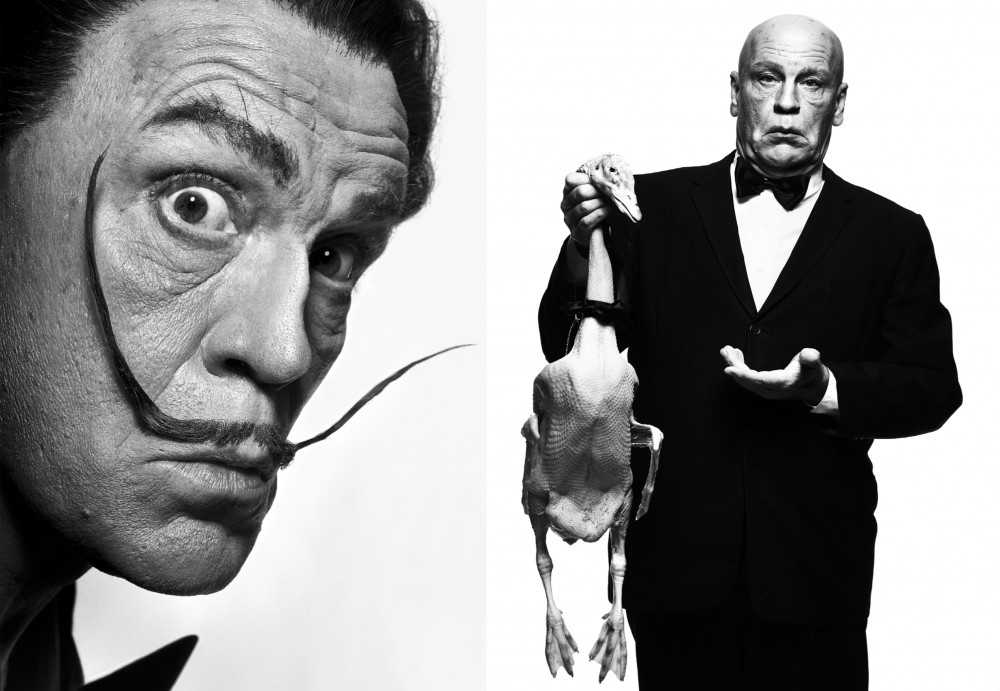 ©Sandro Miller (Left: Philippe Halsman: Salvador Dalí (1954), 2014; Right: Albert Watson: Alfred Hitchcock with Goose (1973), 2014)
©Sandro Miller (Left: Philippe Halsman: Salvador Dalí (1954), 2014; Right: Albert Watson: Alfred Hitchcock with Goose (1973), 2014)
AB: How long did this project take?
SM: The research took over a year to really dissect every single shot: to Google each shot and find out as much as we could about the era, to find out what format the photographer was using, what kind of film the photographer was using, to research the clothing, any prop that may have been in it, the light- ing. It took a little over a year just for research. Then you sit meeting after meeting with your stylist, your hair and make-up people, and talk about the make-up. We have to have wigs made, hair pieces made, beards made: everything has got to be custom made. Take that Hemingway combover that’s impossible to find in a wig store, so you have to have it built.
AB: How did you do this without it conflicting with John’s schedule?
SM: I would talk to John about when he would be back to Chicago. John would tell me, “Hey, I’ll be Chicago and we can shoot these three days or these four days.” Then my crew would work vigorously to get everything together: all the clothing and hair pieces made. They come from all over the country and we have to get them there a week before the shoot.
Prior to John showing up, I set up every single shot in the studio with a stand in because I can’t be practicing and trying to figure out how the original photographer did it with John on set. I have to pre-light everything and I have to write down in a book, down to the last quarter inch, where everything was. Because when I put it back together for John, it’s got to be perfect and ready to go. Our first day of shooting with John, I had six shots completely setup in my studio so that John can go from set to set to set.
AB: You must have a big studio.
SM: I do have a big studio. But most of the sets were pretty small. If you look, most of the sets are back- grounds. Some sets had to be built, but I could still fit 6 to 7 of those, though it is very cramped. And then I have got to have lighting equipment on each one of these sets. Each one is prelit and presetup. John has been in hair and makeup for at least 2 hours on every single shot. After we’re done with one set, we get the next set ready while John is in hair and makeup.
But again, we refer back to our notes and find this light was 16 inches from John in this direction, this one was 18 inches, the background was 8 feet behind him, camera was 32 inches from John, John was at this height, camera was at this height you just take a look at every detail in your notes and you recreate what you’ve already created in the studio so that John is not sitting there waiting for the lights to get perfect. It’s like they do it in any movie set. Everything is pre lit and when the star walks in boom you should be ready to go.
AB: You said John considered this a challenge. Why? He’s done other characters before...
SM: Of course he has, and John is a genius. But could you imagine John pulling off Marilyn Monroe? The challenge is there. The challenge is for both of us to do our jobs to perfection. Could you imagine if put this thing out and it wasn’t as perfect as it is? I would have been another James Franco. I would have been the laughing stock of the photographic community. At this place in my career, we couldn’t do that.
John had the challenge of really, truly achieving the character, becoming the character. Then my chal- lenge was to really nail this down to absolute perfection, and pay true homage to these masters and nail these shots the way they should be nailed. Otherwise this thing would have been a joke, it would not have gone worldwide crazy, and it wouldn’t have been what it is.
AB: Did you ever think you might have problems with copyright infringement?
SM: No, and the reason is this: I never contacted a photographer but if any photographer ever read any of the 150 articles that has been written on this work or listened to any of the interviews that I have given, they would know all I’m doing is paying respect to them. All I’m doing is saying, “Thank you. You guys are amazing. You were great. Thank you for what you gave to us.” I’m not claiming the original idea. It’s my idea to recreate these shots with one guy as a homage.
No, I never thought I was going to have any problems with copyright, I talked to several people about it. If I had done these shots and not given any credit to Irving Penn, Avedon, Annie Leibovitz, Diane Arbus, then I would expect all these foundations to come after me. But my heart has always given credit to where credit’s due and that’s to the masters.
AB: Do you consider yourself a commercial photographer?
SM: Well I’m a commercial photographer and I’m an artist. Why can’t I be both? I’m not just a com- mercial photographer. I have been shooting personal work for 30 years, and I have seven books out. So, no, I’m not just a commercial photographer.
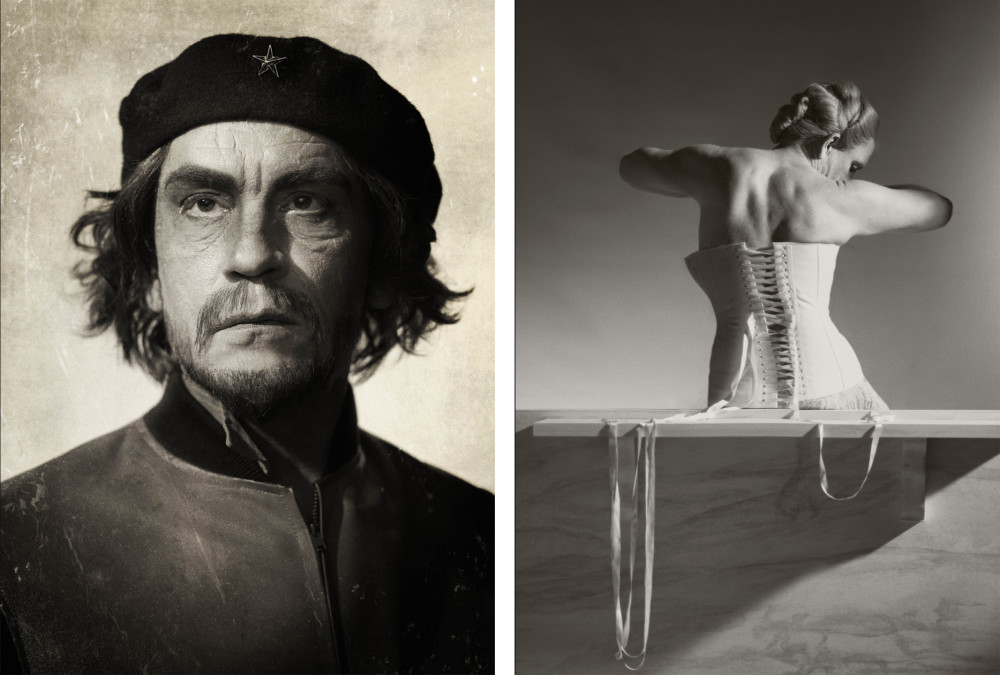 ©Sandro Miller (Left: Alberto Korda: Che Guevara (1960), 2014; Right: Horst P. Horst: Mainbocher Corset (1939), 2014)
©Sandro Miller (Left: Alberto Korda: Che Guevara (1960), 2014; Right: Horst P. Horst: Mainbocher Corset (1939), 2014)
AB: I know that, it wasn’t meant as an insult.
SM: OK
AB: This issue is about vanity. Do you think this project has anything to do with vanity?
SM: Like my vanity?
AB: Either yours or John’s.
SM: I never thought about that. First of all, I never thought this project would be as a successful as it is. I’m so passionate about creating imagery that I create work constantly. It’s almost an illness. I have to be producing work 24/7. It’s just what I do. It’s my life. This was never about me and it was never about John, really. It truly was about the masters. I never thought it would get this type of recognition. I never thought that it would get this type of acclaim. I never thought about myself.
I just thought about my art. It’s a way for me to really give back and say thank you. Like I said, this came really from an illness and you get to a point in your life where you go, “What have I done with my career?” Yes, I have done these great books and I have done these great projects, but I wanted to do another great, great project. And it’s not the only great project I have done since I’ve gotten well. I went to Morocco and I shot 240 portraits in Morocco and that project ended up winning me the International Photographer of the Year Award.
It was me about coming out of this illness and wanting people to know I have two loves: I love my family and love creating great, great work. I wanted to know after this illness if I still had something in me that I could give back to the photographic community that is important. I chose to do both of these projects not knowing either one of them would have done as well as they really did.
But I don’t think about myself when I do these projects. I just create. I don’t think about fame, or money, or any of that. Yes, I would love to leave somewhat of a legend behind: yes, that guy has a tremendous body of work, he was prolific in what he did...I don’t do just advertising, I don’t do just street photog- raphy, I don’t do just portraits. If you take a look at the body of work that I have created over 40 years, I have really done everything and I try to do it really well.
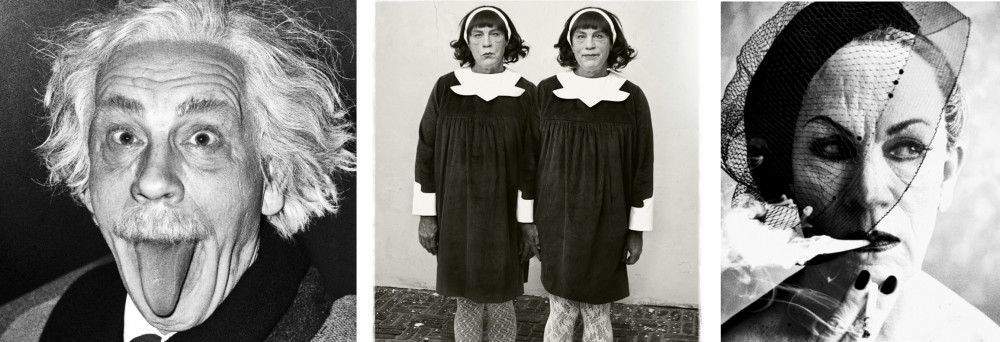 ©Sandro Miller (Left: Arthur Sasse: Albert Einstein Sticking Out His Tongue (1951), 2014; Center: Diane Arbus—Identical Twins, Roselle, New Jersey (1967), 2014; Right: William Klein: Smoke and Veil, Paris (Vogue) (1958), 2014)
©Sandro Miller (Left: Arthur Sasse: Albert Einstein Sticking Out His Tongue (1951), 2014; Center: Diane Arbus—Identical Twins, Roselle, New Jersey (1967), 2014; Right: William Klein: Smoke and Veil, Paris (Vogue) (1958), 2014)
AB: I know! And you do! OK, for instance, when I made the faux pas of calling you a commercial photographer, and it upset you...
SM: Oh no, no. It didn’t upset me, believe me. I hope I didn’t come off as upset. I just wanted to get across that I feel that you were very right in saying, “You are commercial photographer.” I think that’s what most people believe. But I would like them to believe that I’m a little bit more than that. So, it wasn’t that I was upset. It comes from passion. When I talk, I talk with passion. Irving Penn was a commercial photographer but he was also an artist. And he was brilliant. Avedon was a commercial photographer, but he got quite amazing acclaim for his personal work too. I just want people to really understand that I have this amazing personal side to my work too.
AB: I just wanted to ask you how do you think working as a commercial photographer has helped you with your personal projects?
SM: Oh, I’ll tell you exactly how it has helped me: I fund all of my projects. To do this Malkovich project I don’t want to put a number out there, but it’s probably one of my most expensive projects. You’re talking close to a hundred thousand dollars to produce that work. When you’ve got the crews, you’ve got set builders, you’ve got hair that you got to buy that you have specially made, clothing that you had specially made, you walk into the studio the day that we are doing these shots and there is 20 people, it’s a tremendous undertaking.
I was born in a very poor family, so I’m not a hedge fund kid. I have worked very hard and I have a good career in advertising and I use that money to do my personal projects. To go to Morocco for a month and close down my studio, basically, and bring my crew over there and shoot this personal work. Go to Spain to shoot Joselito the great bull fighter or travel the world with these boxers. All of this have been funded through the money I have made in advertising.
But I think that it is my personal work that continues to get me the big advertising campaigns. People see this different side of me and they want to work with an artist. They want to work with somebody with an idea, somebody who has his own vision, because so many people are looking for help today in their campaigns and they want to work with people who are thinkers.
AB: Do you have a favorite image in the Malkovich project?
SM: I really love the one based on Dorothea Lange’s Migrant Mother. I have that image hanging in my house. That image to me depicts what women have gone through in the past and still go through today. I feel like women have been overworked, underappreciated, stuck, and haven’t been given their rights. That shot to me is so powerful, what Dorothea Lange caught in that woman. To me it speaks so loudly to the pain that women have gone through. When I see how John really morphed himself into that woman, it just amazes me.
AB: I would like to respond to a couple of things. First of all, Lange’s original picture was manipulated...
SM: No, it wasn’t manipulated, it was cropped. I don’t think it was manipulated...
AB: I read something about it being manipulated. But I think that is very interesting that your image with John was not manipulated. It’s more real than the real one.
SM: Yes. And it was a very difficult shot to accomplish because you are working with children. We had to find these little kids with the right hair to cut into bobs. There is all kinds of other problems that come into the whole situation with kids moving and being impatient, scared.
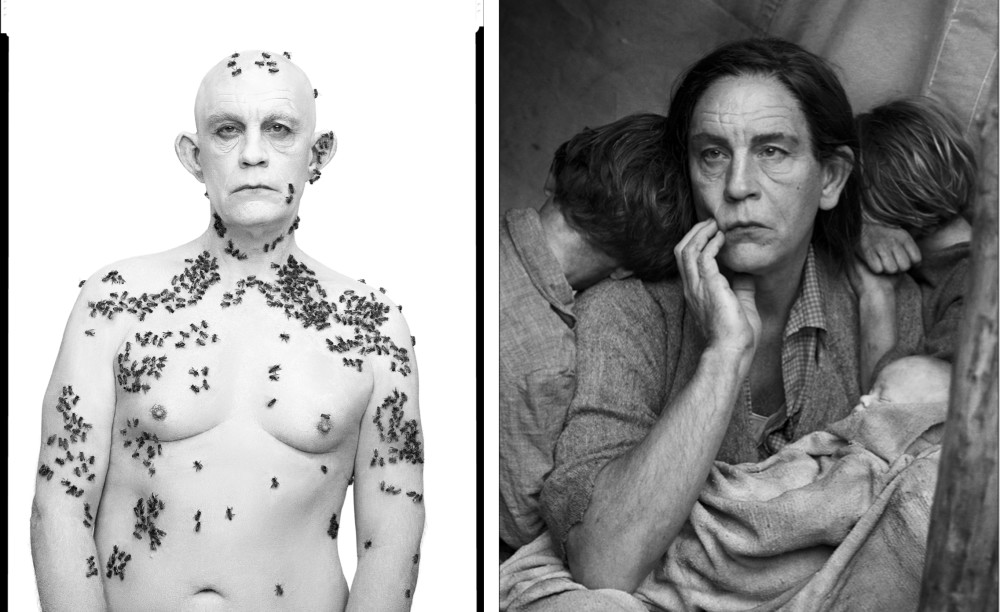 ©Sandro Miller (Left:Richard Avedon: Ronald Fisher, Beekeeper, Davis, California, May 9 (1981), 2014; Right: Dorothea Lange : Migrant Mother, Nipomo, California (1936), 2014)
©Sandro Miller (Left:Richard Avedon: Ronald Fisher, Beekeeper, Davis, California, May 9 (1981), 2014; Right: Dorothea Lange : Migrant Mother, Nipomo, California (1936), 2014)
AB: Generally, how long did each image take you to capture?
SM: Every shot that we created with John was about two hours of hair and makeup and clothing. I would take the original shot that we were recreating and I’d put that shot on the mirror where John was getting his hair and makeup and I would go inside talk to John a little bit about that shot. You could see John beginning to think about Alfred Hitchcock, Ernest Hemingway, Che Guevara, and you could see the wheels starting to turn, the little motions in his face, him beginning to get into character.
Once he came out on the set, everything is completely setup and there is an X when he is supposed to stand, and there are tape marks where both feet need to go. He gets in position. Then I talk to John about that evening: this is Marilyn Monroe with Bert Stern. They’ve been drinking martinis, they are in the So-and-So Hotel. Who knows, there might have been a little bit of sexual contact between the two. There is definitely some flirtation going on. All of a sudden, Bert asked Marilyn to remove her top so he can shoot her nude. So, I’m talking to John like it is that evening, or it is that day at the pea farm where Dorothea Lange took that shot, or it is Albert Watson’s studio with Alfred Hitchcock holding the goose. I’ll talk about how slimy the goose feels in his hands. Or David Bailey’s shot with Mick Jagger: there are other celebrities in the studio, they are smoking pot and they are drinking and it’s almost a party. Because I could just feel that that’s what’s going on in David Bailey’s studio.
AB: That’s wonderful direction.
SM: I was just trying to get him into each situation in his mind. So he begins to feel the evening, and that helps him become that person.
AB: What were you trying to achieve with this work?
SM: Well, I think what I tried to achieve was authenticity I really wanted the authentic feeling. Like Hemingway was toward the part of his life where he was on the edge: he was a bullfight lover, he was a rifleman, he was an alcoholic, he was depressed. If you look at Hemingway in that shot, his eyes are far away. He is not there for Karsh. He is someplace else.
AB: Didn’t you want people to react emotionally to the work, or was that not part of the equation? Did you just want people to say, “My God, he really did this exactly the same as it was”?
SM: I really wanted to achieve perfection. Beside the Serrano shot, Piss Christ, if you look at every other shot, you almost sometimes, and I have even done it myself, people have sent me the Warhol shot and I go, “Wait a minute is this mine or is this Warhol’s?” It sounds silly, but if I’m not in like the perfect frame of mind I can’t tell which one is which. I was trying to really truly replicate as close as possible, except for the Andrea Serrano, I couldn’t do that. But that’s my interpretation of Piss Christ.
AB: You’ve been working as a photographer for a while now. What advice would you give someone who is just starting?
SM: First, you’ve got to have an amazing, unstoppable passion for what you are doing. Really get in touch with your heart. Is making imagery what you want to do every single day for the rest of your life? Do you want to be like everybody else: mediocre? Or do you want to rise to the top? And if you do want to rise to the top you are going to have to work at it every single day. You are going to have to get consumed by photography. You have to take pictures everyday, you have to look at photography everyday, you have to look at photography from around the world, you have to study it, you have to find out who your masters are and study them. You have to work tremendously hard. It’s the most joyous occupation in the world. I have met so many amazing people through my work, travelling all over the world. But it takes tremendous amount of passion and love for what you are doing to really stand out.
AB: What’s your next project?
SM: I have three personal projects in house right now that I’m doing. I just got back from St. Barths and I was on the beaches there and they have the most beautiful rocks in the world. I brought some back with me. I look at these rocks and they look like faces to me. I see Charles Bukowski, I see Jim Durante, I see amazing faces in these rocks. So I’m doing portraits of these rocks that look like faces. That’s one thing I’m working on right now. I have this incredible passion to get to Kenya and get into the bush. There is around 67 tribes in Kenya and I would love to visit all of these tribes and do portraits of the people. I’m trying to work that out for next year. I’m working on a big documentary right now on the wonderful Chicago artist Nick Cave.
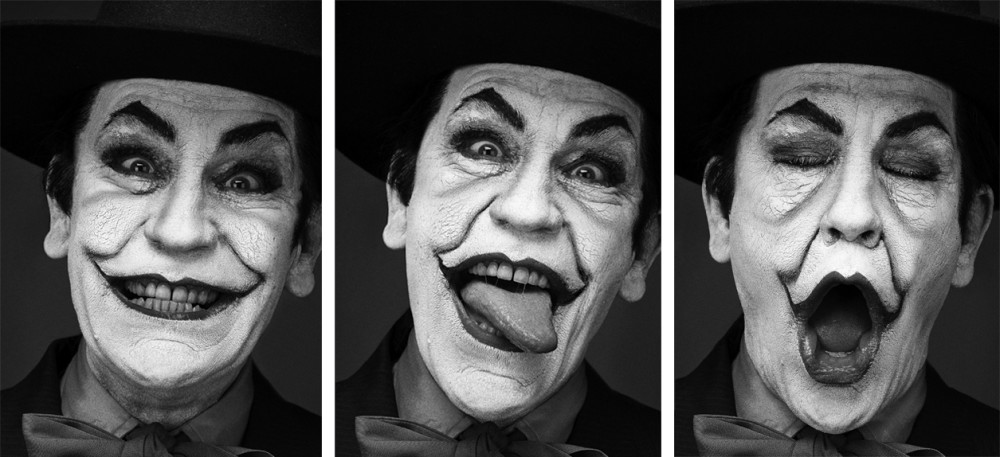 ©Sandro Miller (Herb Ritts: Jack Nicholson, London (1988), 2014)
©Sandro Miller (Herb Ritts: Jack Nicholson, London (1988), 2014)
AB: He was on our cover for issue 7. He is inspiring.
SM: He is amazing. I absolutely love him. I did 7 or 8 art films with him about a year and a half ago. He had a bunch of big museum shows and he wanted to have these rooms with videos in them. So I created videos with him and that was where I fell in love with Nick and his work. And now I’m work- ing on a documentary with him.
AB: You are a very busy man.
SM: Well, thank you. I still find time for my family and for travelling. I’ve learned to be much more bal- anced. I used to be really crazy prolific. I always wanted to be shooting something, creating something. I have really learned to take time for myself and make time for other joys I have in my life.
All Images Courtesy of Catherine Edelman Gallery

